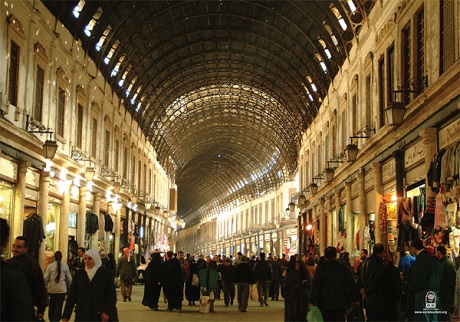A Contemporary eye witness on events and traditions
Souk al Hamidiya is the most famous historical bazaar in the heart of Damascus. It extends north east inside the old city, from the tips of the western wall of the Damascus citadel, to reach al Miskiye ; that is, from al Nasr street to Bab al Breed near the columns of the temple of Jupiter.
The souk was built in two stages:
The first stage was finished during the rule of sultan Abdul Hamid I, when Mohammad Pasha al Azem was the govorner of Damascus. The souk started from al Darwishia and ended in al Asrouniyeh. This stage was finished in 1780, after which the souk was named the “new bazaar“.
The second stage: In this stage the souk was extended from souk al Asrouniyeh to Bab al Breed during the rule of Sultan Abdul Hamid II, 1883. To enlarge the souk, a narrow gate known as Bab al Nasr was removed to allow enlarging the main present entrance which leads to al Nasr street.
Renovation and Roofing of the Souk. In 1884 the souk was renovated and completely roofed with wooden boards. The wooden roof was later replaced by new corrugated tin boards to avoid fires.
Names of the Souk:
The souk was originally known as souk al Arwam after the Romans who settled in Syria in the first century A.D. When it was built again in 1780 it was named the New Souk. Only when its eastern part was completed the souk took its present name, al Hamidiya from the name of the two Ottoman sultans who ordered it to be built. Later souk al Hamidiye became the main commercial center in Damascus. It is 600 m long, 15m wide with shops of two stores on both sides, about 12 – 15 m high.
Disasters passed by the souk:
 Souk al Hamidiya survived many disasters, each one of them was big enough to eliminate it. On 1911 it had a large fire which burnt many of its commercial stores. In 1914, to connect the souk with al Nasr street, which was named after him, Jamal Pasha, commander of the 4th Ottoman army in Syria, had to uncover the western wall of Damascus citadel. He started to destroy some of the buildings when the WWI started. Immediately after the withdrawal of the Ottoman army from Damascus, owners of the destroyed shops rebuilt them again.
Souk al Hamidiya survived many disasters, each one of them was big enough to eliminate it. On 1911 it had a large fire which burnt many of its commercial stores. In 1914, to connect the souk with al Nasr street, which was named after him, Jamal Pasha, commander of the 4th Ottoman army in Syria, had to uncover the western wall of Damascus citadel. He started to destroy some of the buildings when the WWI started. Immediately after the withdrawal of the Ottoman army from Damascus, owners of the destroyed shops rebuilt them again.
In the 27th of July 1920 another fire blazed the souk and reached the Umayyad Mosque. After 3 days of raging flames authorities demolished some houses by dynamite to stop the fire.In 2002 – 2003 the souk was renovated and all the columns of the shops on both sides were revealed so that the souk was restored into its original shape.
Branches of the souk:
Many smaller souks branch from the main Hamidiya Souk, each of them is specialized in one kind of commodity.
On the southern side: souk al Arwam, al Hariqa entrances, al Maristan, al Suleimaniya, and the Silk Souk.
On the northern side:
Souk Nasri, souk al Asrouniyeh, souk al Bourse, souk Mardam peck, Souk of Socks, Souk al A’cha, souk Bab al Breed.
Specialties of the souk:
Souk al Hamidiya has about 250 stalls and shops that sell textiles, cotton fabrics, readymade clothes, scarves, head covers, oriental souvenirs, musical instruments, jewelry, carpets, perfumes, ice cream and beverages, towels, lingerie, shoes, leather wears, kitchen wares, sports wears, bags, cosmetics, perfumes, watches and clocks, Hubble bubbles and accessories.
Haifaa Mafalani

